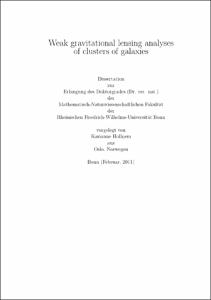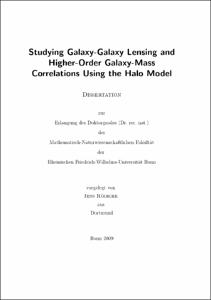E-Dissertationen: Search
Now showing items 1-8 of 8
Weak gravitational lensing analyses of clusters of galaxies
(2011-04-04)
Comprising the most massive gravitationally bound and relaxed structures in the Universe, galaxy clusters are essential in providing a deeper understanding of the properties of dark matter. Being cosmologically young ...
Studying Galaxy-Galaxy Lensing and Higher-Order Galaxy-Mass Correlations Using the Halo Model
(2009-06-22)
In recent years, the distribution of galaxies in the Universe could be measured up to large distances and over a significant part of the sky. The analysis of this large-scale structure contains a wealth of cosmological ...
Cosmic Shear and the Intrinsic Alignment of Galaxies
(2010-11-12)
Cosmology has recently entered an era of increasingly rich observational data sets, all being in agreement with a cosmological standard model that features only a small number of free parameters. One of the most powerful ...
Measuring cosmological weak lensing using the Advanced Camera for Surveys on board the Hubble Space Telescope
(2008)
Following from the theory of General Relativity, light-bundles are deflected and differentially distorted while passing through the gravitational potential of matter inhomogeneities. The gravitational lensing effect caused ...
The non-Gaussian matter power spectrum covariance in the halo model approach
(2008)
Weak gravitational lensing is one of the most promising tools to analyze the nature of dark energy and dark matter. In order to constrain cosmological parameters with this method a good theoretical understanding of the ...
Weak Gravitational Lensing and Galaxy Bias
(2005)
Galaxies were formed from primordial baryonic matter within the gravitational potential of the dark matter. Today a confusing wealth of different galaxy populations is known. Explaining the emergence of this zoo of galaxy ...
Exploring Dark Matter Properties from the Smallest to the Largest Scales
(2004)
One of the main problems in cosmology is to understand the formation and evolution of galaxies, galaxy clusters, and large-scale structure. Whereas the basics of the current Cold Dark Matter (CDM) paradigm for structure ...
Halo bias renormalisation
(2020-06-09)
Modern galaxy redshift surveys provide a wealth of information about the evolution of our Universe. They allow to measure both the two-dimensional position on the sky and the distance (given by the cosmological redshift) ...










